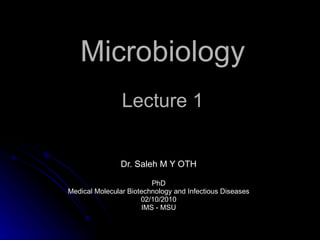
Microbiology lec1
- 1. Microbiology Lecture 1 Dr. Saleh M Y OTH PhD Medical Molecular Biotechnology and Infectious Diseases 02/10/2010 IMS - MSU
- 2. Microbiology is the science that deals with tiny organisms that can’t be seen by naked eye. -micro=tiy , -bio=alive , - logy=science Introduction In general; we call this part of the science : Microbiology and the organisms called Microorganisms These microorganisms are widley distributed in nature and some of them are beneficial to man and some of them are harmful (pathogenic; cause diseaes) .
- 3. In our field of medical microbiolgy , we deal with microbs that cause diseases to man. Microbiology Viruses = Virulogy Bacteria = Bacteriolgy Fungi = Mycology Parasites = Parasitology Immunity = Immunology Antibiotics = in use for treament Medical Microbiology Food Microbiology Water Microbiology Air Microbiology Soil Microbiology Space Microbiology Industrial Microbiology Pranches of Microbiology Algae = Phycology Prtotzoa = Protozoology
- 4. The harmful microbs (agents) called pathogens Thus; the agents of human infecious diseases belong to 5 major groups: 1- Viruses 2- Bcateria 3- Fungi 4- Protozoa 5- Helminths Parasites Viruses are quite distinct from the other organisms as they are NOT cells but can replicate only within cells.
- 5. BACTERIA are microscopic unicellular Prokaryotes, the MOST Numerous Organisms on the Earth Evolution and Classification of Bacteria Bacteria have evolved into many different forms, and they are now part of nearly every environment on the Earth. They have been found at the bottom of the oceanic trenches 9.6 km (6 mi) below the water's surface and in Arctic and Antarctic Regions.
- 6. Evidence in the fossil record indicates that Prokaryotes are about 2.5 Billion Years Old and Modern Humans arose about 100,000 years ago. Unlike most other organisms, Bacteria have few Morphological differences that can be used to classify them. Bacteria do Not vary in size and shape to the extent that other types of organisms do. Classicaly, bacteria have been grouped based on their Structure , Physiology , Molecular Composition , and Reaction to specific types of stains (Gram Stain), rather than on their evolutionary relationships.
- 7. Bacteria can be one of THREE Different SHAPES: The three common types of bacterial morphology; Cocci - coccus , Bacilli - bacillus , spirillum These types: spherical, rod and sprial shaped morphologies are typical of such genera as: Streptococcus / Staphylococcus , Escherichia / Bacillus and Leptospira / Spirillum .
- 11. 1- LAG PHASE: Growth is slow at first, while the "bugs" acclimate to the food and nutrients in their new habitat. 1 2 3 4 2- LOG PHASE: Once the metabolic machinery is running, they start multiplying exponentially, doubling in number every few minutes. 3- STATIONARY PHASE: As more and more bugs are competing for dwindling food and nutrients, booming growth stops and the number of bacteria stabilizes. 4- DEATH PHASE: Toxic waste products build up, food is depleted and the bugs begin to die. Growth Curve
- 12. STRUCTURE of the BACTERIAL CELL
- 13. Bacteria are Typically composed of: Cell Wall, Cell Membrane, and Cytoplasm Some bacteria have Distinctive Structures, such as Endospores , Capsules , and Outer Membranes . The Variety of Structures among Bacteria is due to adaptations to individual to take its place in the world.
- 15. Capsule Cell wal Plasma membrane Cytoplasm Riposomes Plasmid Pili Nucleoide (circular DNA) Bacterial Flagellum
- 17. CELL WALL bacteria have a Cell Wall and its function is to protect the bacterial cells from bursting or destroys and gives the bacteria its shape.
- 20. STRUCTURAL CHARACTERISTICS OF A BACTERIAL CELL moves the cell Flagellum assist the cell in attaching to other surfaces, which is important for genetic recombination Pilus (Pili) protects the cell against harsh environmental conditions, such as heat or drought Endospore protects the cell and assist in attaching the cell to other surfaces Capsule, and slime layer contains some genes obtain through genetic recombination Plasmid carries genetic information inherited from past generations Chromosome contains DNA, ribosomes, and organic compounds required to carry out life processes Cytoplasm regulates movement of materials into and out of the cell; contains enzymes important to cellular respiration Cell Membrane protects the cell against some antibiotics (only present in Gram-negative cells) Outer Membrane protects the cell and gives shape Cell Wall FUNCTION STRUCTURE
- 21. w
